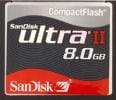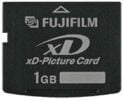Memory cards are used for storage, but there are different kinds and types of memory cards. Confused? Webopedia has you covered with all the different types and formats of memory cards, their sizes, prices, and more.
|
Memory cards are a popular storage medium for many of today’s consumer electronics devices, including digital cameras, cellphones, handheld devices and other small electronic devices. Flash memory is nonvolatile, that is the memory card will not lose its data when removed from the device, and the cards can also be erased or reformatted and reused. For most consumers, when buying a memory card you have to consider price, capacity and compatibility. Some devices will support up to a specific size of memory card, and a specific type of memory card as well. Its important to read the information that came with your device to ensure you purchase a memory card that will work in your device. There are a few major types of memory cards that can be used in common electronics, such as a digital camera. Each of these types of memory cards are different sizes and, as the technology progresses further, we see that over time the cards have become smaller in physical size but grow larger in logical size. Common Types of Memory CardsPCMCIA (Personal Computer Memory Card International Association)
|
CompactFlash (CF)
Invented by SanDisk Corporation in 1994, CompactFlash cards can support 3.3V and 5V operation and can switch between the two, in contrast to other small-form factor flash memory cards that can operate only at one voltage. The card was designed based on the PCMCIA PC Card standard and can fit into a PCMCIA slot with an adapter. There are two types of CompactFlash cards to accommodate different capacities:
- Type I cards are 42.8mm x 36.4mm x 3.3 mm thick
- Type II cards are 42.8mm x 36.4mm x 5.5 mm thick.
Secure Digital Card (SD card)
SD cards are used in many small portable devices such as digital video camcorders, digital cameras, handheld computers, audio players and mobile phones. In use since 1999, SD Memory Cards are now available in capacities between 16 Megabytes and 1 Gigabyte, and still growing. An SD card typically measures 32 mm x 24 mm x 2.1 mm and weighs approximately 2grams.
MiniSD Card
After the success of the SD Card (Secure Digital Card), the miniSD Memory Card was developed to meet the demands of the mobile phone market. The MiniSD Card provides the same benefits as the SD Card, but is smaller than the original SD Card. MiniSD Cards are typically found in many newer mobile phones with features such as built-in digital cameras, downloading and games, basically the mobile phones where the miniSD can meet the requirements for increased data storage. MiniSD cards are 21.5 mm x 20 mm x 1.4 mm and generally provide 16MB to 256MB of storage.
MicroSD
Mainly used in mobile phones and other small handheld devices the MicroSD format is currently available in capacities up to 4GB, and it roughly 1/4th the size of the SD card at 15mm W 11mm W 0.7mm. The MicroSD card is also the smallest memory card available.
Card adapters can be purchased that enable backwards compatibility this would allow MicroSD cards to work in SD and MiniSD slots, and also for MicroSD cards to work in SD card slots.
MultiMediaCard (MMC)
The MultiMediaCard (MMC) standard was introduced by SanDisk and Siemens in 1997. The card itself is 32 mm x 24 mm x 1.4mm and is often used in place of the SD card. Transfer speeds of a MMC is around 2.5MB/s and they can often be used in SD Card readers.
Sony Memory Sticks
Sony Memory Sticks are light, compact and designed for a wide variety of devices including digital cameras, recorders, and more. With the use of an adapter most Sony Memory Sticks can be used with almost all Memory Stick PRO compatible products.
- Memory Stick Micro (M2): 15 mm x 12.5 mm x 1.2 mm
- Memory Stick PRO: 50 mm x 21.5 mm x 2.8 mm. The Memory Stick PRO format has an an 8-bit parallel interface with theoretical transfer rates up to 480Mb/s. It is commonly used in high megapixel digital cameras and digital camcorders.
- Memory Stick PRO DUO: 31 mm x 20 mm x 1.6 mm. The Memory Stick PRO Duo media is about one-third the volume and half the weight of standard-size media, but offers all the advanced functions of Memory Stick PRO media.
SmartMedia
Introduced by Toshiba in 1995 the SmartMedia cards are now considered obsolete despite its popular usage for five years. SmartMedia cards are 45 mm x 37 mm x 0.76 mm and could be found in their peak times in 16MB, 32MB, and 128MB versions. Even as an obsolete card, it is still sought after by users of older devices which cannot use memory cards larger than 128MB.
xD-Picture Card
Abbreviated as xD (Extreme Digital), the xD-Picture Card is a type of removable flash memory designed for use in digital cameras. The xD is ultra-compact with its size of 20mm x 25mm x 1.7mm. The xD-Picture Card was developed by Fuji film and Olympus and are used in many models of digital cameras made by Olympus and Fujifilm.
Lifespan and Care Tips
Memory cards are quite sturdy and you can expect cards to be capable of working through more than one million data write/read/erase cycles. The card itself has its weakest point at its socket connectors, which are used when you remove and reinsert the memory card into a device. You can expect a memory card to be capable of withstanding around 10,000 insertions. These numbers, of course, will differ slightly between manufacturers.
Like with any consumer electronic or device, proper care is required by the users to meet the lifespan of the device. You should avoid applying too much pressure on your memory cards, and never drop or bend the card either. When the correct memory card is being used in a device, it will fit into the slot only in one direction and it will easily slide and click into place. You should never have to apply any amount of pressure to make the card fit. Memory cards should also be kept away from electrostatic sources and should never be introduced to direct sunlight or extreme ranges of temperatures.
Lastly, damaging the card or the data contained on it can happen if you try to eject the card from the device or card reader, or if you try and turn the device off while you are transferring the data to or from the memory card. So definitely avoid doing that to protect your data and card itself.
Today’s Market & Prices
| Compact Flash (CF) | Secure Digital (SD) Card | xD-Picture Card | Sony Memory Stick PRO Duo | |
 42.8mm x 36.4mm x 3.3 mm |
 24mm W 32mm W 2.1mm |
 20mm x 25mm x 1.7mm |
 31 mm x 20 mm x 1.6 mm |
|
| SanDisk 8GB CF Type II card $27 Transcend 4GB CF Type I Card $20 |
Sandisk 4GB Secure Digital Card $5 | Fuji 2GB XD Card $27 | Sony 4GB Memory Stick Pro Duo $12 |
[Current Price examples & images from TigerDirect.com and Google Shopping- 02/03/14]
|
Did You Know… |
| Key Terms To Understanding Memory Cards:
NAND USB card reader smart card |
Based in Nova Scotia, Vangie Beal is has been writing about technology for more than a decade. She is a frequent contributor to EcommerceGuide and managing editor at Webopedia. You can tweet her online @AuroraGG.
This article was originally published on October 05, 2007

